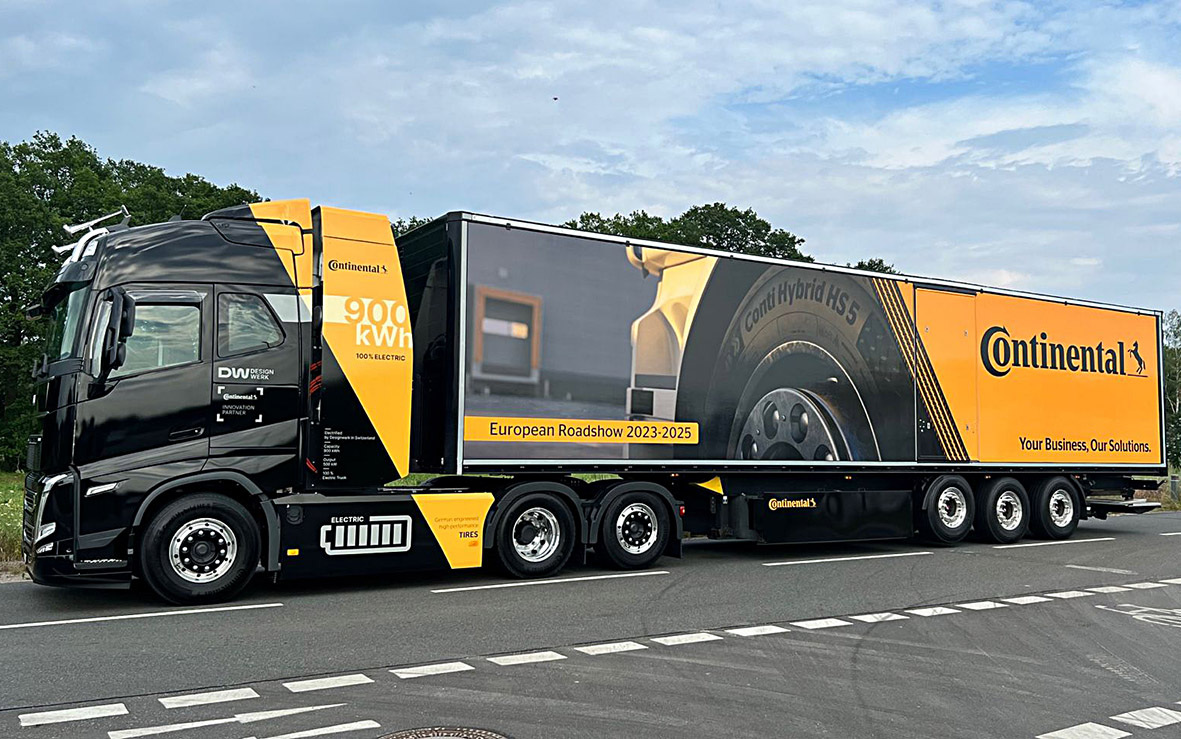Diesels are still humming on our roads: In 2022, 1,656 fully electric trucks were registered in the EU – out of just under 284,000 new registrations, a share of just half a percent. Again, half of these new e-vehicles are on the road in Germany – as part of a fleet that now numbers a good 60,000 e-trucks.
One thing is certain: the e-fleet will grow. The EU’s climate protection targets are ambitious; by 2040, manufacturers are to reduce CO2 emissions from new vehicles by 90 percent. Our #ContiEuropeanRoadshow is also electric on selected sections of the route. We are using a HIGH CAB Semi 6x2T tractor unit from our innovation partner Designwerk, which is based on the Volvo FH series. The vehicle, which has a 900-kilowatt-hour battery capacity, thus demonstrates its long range and will cover distances of around 500 kilometers without intermediate charging. That’s definitely enough even for demanding logistics tasks!
But what are the benefits of using a modern electric vehicle instead of the tried-and-tested diesel? We have compared the advantages and disadvantages.
Environment
Less noise and no direct exhaust emissions – these are the benefits of electric trucks not only in city centers, but also for drivers, who are much more comfortable on the road. In the long term, the electric trucks should above all reduce CO2 emissions. They already consume less energy per kilometer thanks to their significantly improved efficiency compared with combustion engines. But for them to be really effective in reducing the burden on the environment, substantial investment is still needed in the expansion of renewable energies. And there is still a lot of room for improvement in the production and processing of batteries. But somehow we have to start saving the world …
Acquisition
There’s no question that electric cars are more expensive than their diesel counterparts. However, a large part of the additional costs can be recouped through government subsidies. There are also far fewer electrically powered variants available. As a result, not everyone can find the right model for their needs. And those who do find one often have to be patient. For many manufacturers, delivery times are longer than for combustion engines.
Maintenance
As long as electricity is cheaper than fuel, transport companies with electric vehicles save on every kilometer. Even more savings can be made by those who generate their own electricity, for example with a company-owned solar power system. In addition, the electric drivetrain convinces with low maintenance requirements because it gets by with far fewer moving parts and, as a rule, with a gearshift- and clutch-free transmission. And of course, the electric vehicles do not require an emissions test. In addition, the recovery of braking energy not only increases efficiency, but also reduces wear on the brakes. Furthermore, transport companies save time and money on bypasses or fees for entering environmental zones.
Driving characteristics and comfort
What truckers notice first is the enormous acceleration of the e-trucks – and it’s stepless and virtually silent. Pleasant in winter: The cab warms up faster than in diesel trucks. To ensure that this does not affect the range, pre-conditioning at the charging station is recommended.

The Designwerk truck for the #ContiEuropeanRoadshow at the charging station. Photo: Designwerk, Jens Bahrmann
Refueling/charging
Diesel trucks are supplied with fuel in no time at the approximately 140,000 filling stations in Europe. E-trucks, on the other hand, stand at the charging station for two to nine hours until the battery is full again. Public charging points? Almost completely absent. This is to change as quickly as possible, but it is still unclear how. However, Europe’s three largest truck manufacturers, Daimler, Traton and Volvo, have been working together since 2022 to set up a high-performance charging network for heavy trucks, with at least 1,700 charging points near highways and important transshipment points. And fast chargers like the Mobile Charger 22-500 from Designwerk ensure that even powerful batteries can be charged in no time at all.
Have you already gained experience with an e-truck? Then tell us about it in a comment!


0 Comments